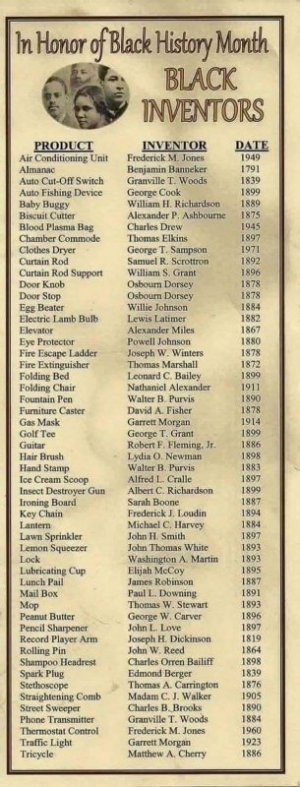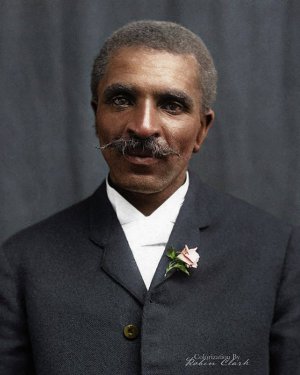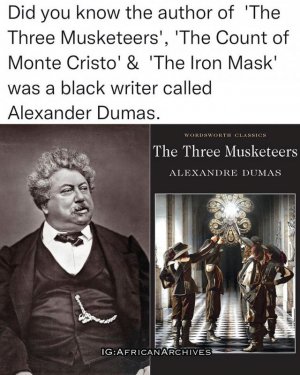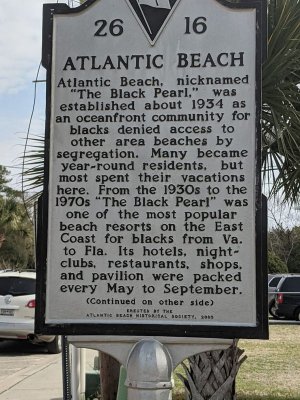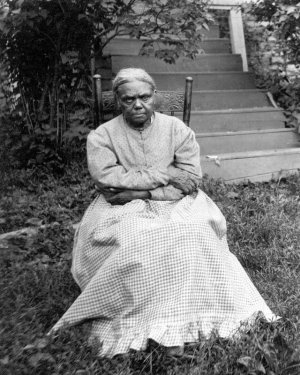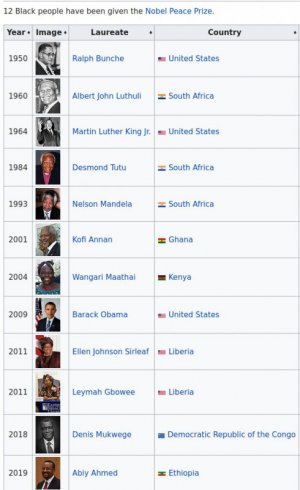You are using an out of date browser. It may not display this or other websites correctly.
You should upgrade or use an alternative browser.
You should upgrade or use an alternative browser.
In Honor of Black History month...
- Thread starter SmoothSeas
- Start date
SmoothSeas
Senior Member
George Washington Carver was an agricultural scientist and inventor who developed hundreds of products using peanuts (though not peanut butter, as is often claimed), sweet potatoes and soybeans. Born into slavery a year before it was outlawed, Carver left home at a young age to pursue education and would eventually earn a master’s degree in agricultural science from Iowa State University. He would go on to teach and conduct research at Tuskegee University for decades, and soon after his death his childhood home would be named a national monument — the first of its kind to honor an African American.
photo taken c. 1910.
officerripley
Well-known Member
- Location
- Porlock, Calif
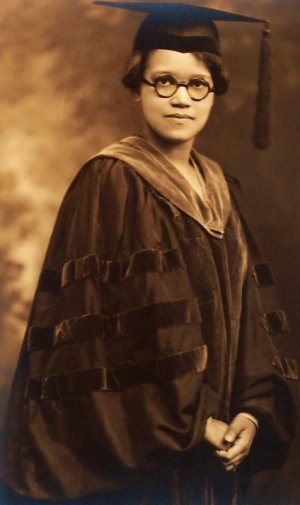
Charlotte E. Ray is the first black female admitted to practice law in the United States of America. To read the rest of the article: https://www.messalaw.com/charlotte-e-ray-americas-first-female-black-lawyer/
SmoothSeas
Senior Member
SmoothSeas
Senior Member
officerripley
Well-known Member
- Location
- Porlock, Calif
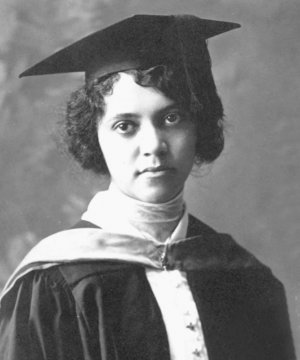
Alice Ball, born in 1892 and a chemist with a Masters degree in Science from Hawaii University, discovered that injecting oil from the chaulmoogra tree would be a more effective treatment for leprosy, which was used 'till the 1940s when sulfone drugs were developed. To read the rest of the article: https://www.biography.com/scientist/alice-ball.
SmoothSeas
Senior Member
there has to be thousands, upon tens-of-thousands of untold stories, that deserve to be shared. Here is just one of them...
This is Aunt Polly Jackson from the 19th century.
She was once enslaved, but managed to escape after she could no longer take the brutal working conditions that was forced upon her since birth and well into her old age. Like many others, Aunt Polly escaped slavery via the Underground Railroad and settled in Ripley, Ohio.
She dedicated the rest of her life to helping others win their freedom by opening up her home and feeding those who either came to Ohio to settle or those who just needed some rest before continuing further up north.
During this time, anti-abolitionists had set up what was called the reverse underground railroad, which was a practice of kidnapping not only the enslaved that had managed to escape, but also those who were already free. The reverse underground railroad operated for 85 years from 1780 to 1865.
Aunt Polly would deliberately dress herself to appear as a weaker older lady in order to fool the anti-abolitionists who typically were not interested in capturing older people. Her weapon of choice was a butcher knife, which she hid under her clothes and a kettle of boiling water. Aunt Polly was able to successfully fight off several slave catchers while working along the Underground Railroad.
This is Aunt Polly Jackson from the 19th century.
She was once enslaved, but managed to escape after she could no longer take the brutal working conditions that was forced upon her since birth and well into her old age. Like many others, Aunt Polly escaped slavery via the Underground Railroad and settled in Ripley, Ohio.
She dedicated the rest of her life to helping others win their freedom by opening up her home and feeding those who either came to Ohio to settle or those who just needed some rest before continuing further up north.
During this time, anti-abolitionists had set up what was called the reverse underground railroad, which was a practice of kidnapping not only the enslaved that had managed to escape, but also those who were already free. The reverse underground railroad operated for 85 years from 1780 to 1865.
Aunt Polly would deliberately dress herself to appear as a weaker older lady in order to fool the anti-abolitionists who typically were not interested in capturing older people. Her weapon of choice was a butcher knife, which she hid under her clothes and a kettle of boiling water. Aunt Polly was able to successfully fight off several slave catchers while working along the Underground Railroad.
@SmoothSeas Thank you for this thread honoring Black History Month. More information, short podcast and photos in link.
https://www.npr.org/2022/02/01/1076141993/black-history-harry-hariette-moore
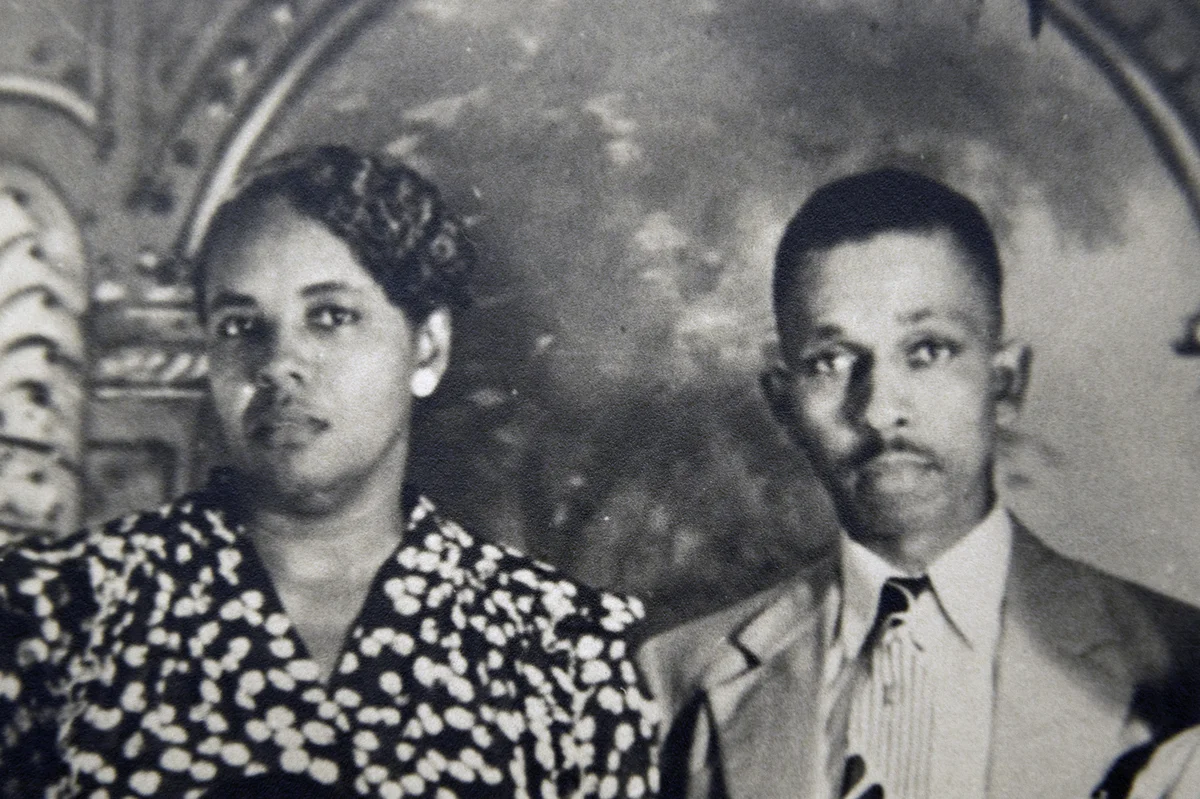
https://www.npr.org/2022/02/01/1076141993/black-history-harry-hariette-moore
Remembering the man who 'laid the groundwork for the modern civil rights movement'

Seventy years ago, one of the first civil rights leaders of the modern era was killed in a bombing in Florida. Harry T. Moore isn't as well known as civil rights icons Medgar Evers or Martin Luther King Jr. Moore's activism began earlier, in the 1930s. His work in Florida investigating lynchings and registering African Americans to vote cost him his life.
He lived and carried out his work from his home in Mims, a small town on Florida's Atlantic coast, where he lived with his wife, Harriette Moore, and two daughters. Today, it's home to the Harry T. & Harriette V. Moore Cultural Complex.
School groups visit almost daily. There's a museum where visitors hear about Harry T. Moore's early history. He and his wife were both teachers who lost their jobs because of Moore's activism. Undeterred, he became the NAACP's executive secretary in Florida, traveling the state, fundraising, organizing chapters and registering voters.
Bill Gary, a former head of the NAACP in Brevard County, says Moore "laid the groundwork for the modern civil rights movement. Moore was fighting for the right to register Black voters. Moore was fighting to get anti-lynching legislation passed. He was fighting to equalize Black and white teachers' salaries."
Alligatorob
SF VIP
Neither did I Alexandre Dumas. I did know he was a great writer. Something satisfying in knowing his color didn't matter much.I didn't know this...
OneEyedDiva
SF VIP
- Location
- New Jersey
I posted this today because I didn't see that you have posted it yesterday...sorry! I wish the mis-educated people who say that Blacks never contributed anything to this country would see this! @SmoothSeas
Last edited:
OneEyedDiva
SF VIP
- Location
- New Jersey
This was posted on Bing
"To mark the beginning of Black History Month, we're paying tribute to one of the few all-Black combat regiments in World War I, true heroes who were instrumental in achieving the Allied victory. The storied 369th Infantry Regiment, famously known as the Harlem Hellfighters, served in frontline trenches for 191 days—longer than any other American unit in the war—and suffered 1,500 casualties, the most losses of any American regiment. They fought under the 16th Division of the French army, because many white Americans refused to go into combat alongside Black soldiers.
But the men of the 369th quickly proved their bravery and combat skills. Their heroism in battle earned them the respect of their French comrades, who awarded them—before any other American unit—the prestigious Croix de Guerre, France's highest award for bravery. It also earned them the fear of the enemy—media reports credited the Germans for bestowing their nickname, 'Hollenkampfer,' or 'Hellfighters.'
Soldiers of the 369th are pictured here on February 17, 1919, on their victorious return to New York City after the war. Around 250,000 people gathered to greet them. Accompanied by music from the Hellfighters band, led by James Reese Europe, they paraded north from Fifth Avenue at 23rd Street to 145th and Lenox in Harlem. Around 70% of the regiment's members called Harlem home, and their family, friends, and neighbors were among those cheering their return. On this day during a month that would eventually be set aside for Black history, these soldiers were given a hero's welcome. A few months later, as General John J. Pershing led soldiers along Fifth Avenue in a much larger victory parade, not one Black soldier was honored. Despite the sacrifice and bravery of the Harlem Hellfighters, the country remained segregated, both in its military and its society writ large.
More from Wikipedia:
https://en.wikipedia.org/wiki/369th_Infantry_Regiment_(United_States)
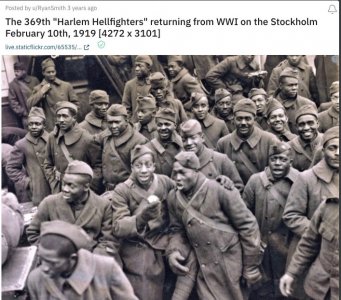
"To mark the beginning of Black History Month, we're paying tribute to one of the few all-Black combat regiments in World War I, true heroes who were instrumental in achieving the Allied victory. The storied 369th Infantry Regiment, famously known as the Harlem Hellfighters, served in frontline trenches for 191 days—longer than any other American unit in the war—and suffered 1,500 casualties, the most losses of any American regiment. They fought under the 16th Division of the French army, because many white Americans refused to go into combat alongside Black soldiers.
But the men of the 369th quickly proved their bravery and combat skills. Their heroism in battle earned them the respect of their French comrades, who awarded them—before any other American unit—the prestigious Croix de Guerre, France's highest award for bravery. It also earned them the fear of the enemy—media reports credited the Germans for bestowing their nickname, 'Hollenkampfer,' or 'Hellfighters.'
Soldiers of the 369th are pictured here on February 17, 1919, on their victorious return to New York City after the war. Around 250,000 people gathered to greet them. Accompanied by music from the Hellfighters band, led by James Reese Europe, they paraded north from Fifth Avenue at 23rd Street to 145th and Lenox in Harlem. Around 70% of the regiment's members called Harlem home, and their family, friends, and neighbors were among those cheering their return. On this day during a month that would eventually be set aside for Black history, these soldiers were given a hero's welcome. A few months later, as General John J. Pershing led soldiers along Fifth Avenue in a much larger victory parade, not one Black soldier was honored. Despite the sacrifice and bravery of the Harlem Hellfighters, the country remained segregated, both in its military and its society writ large.
More from Wikipedia:
https://en.wikipedia.org/wiki/369th_Infantry_Regiment_(United_States)

Last edited:
Shero
Senior Member
- Location
- Transient in the Land of Oz
Neither did I Alexandre Dumas. I did know he was a great writer. Something satisfying in knowing his color didn't matter much.
In France, it does not matter. Dumas mother was an enslaved black woman from Haiti and his father a French nobleman.
His father took him back to France. Before he became a writer, he was in the French army and became the first black French General.
Jessica Watkins is getting ready to be the first Black woman to spend months in space
More info and short podcast found in link. Congratulations to this young lady, I wish her well in her life and career.https://www.npr.org/2022/01/31/1077...astronaut-international-space-station-artemis

After an enrichment program at Sally Ride Elementary School, a young Jessica Watkins realized what she wanted to do when she grew up: study the geology of other planets.
Today, at 33 years old, Watkins is training for a mission to do just that.
This April, Watkins is set to become the first Black woman to live and work on the International Space Station for an extended mission. She will arrive there onboard a SpaceX capsule and then spend six months on the ISS as part of NASA's Artemis program, a multi-billion dollar effort designed to return humans to the surface of the moon in 2025.
"We are building on the foundation that was laid by the Black women astronauts who have come before me," Watkins told NPR's Morning Edition. "I'm definitely honored to be a small part of that legacy, but ultimately be an equal member of the crew."
Of the roughly 250 people who have boarded the ISS, fewer than 10 have been Black. Prior to the inception of the space station, Mae Jemison, an engineer and physician, became the first Black woman to travel to space in 1992. Other Black women have followed, including NASA astronauts Stephanie Wilson and Joan Higginbotham.
Jean-Michel Basquiat
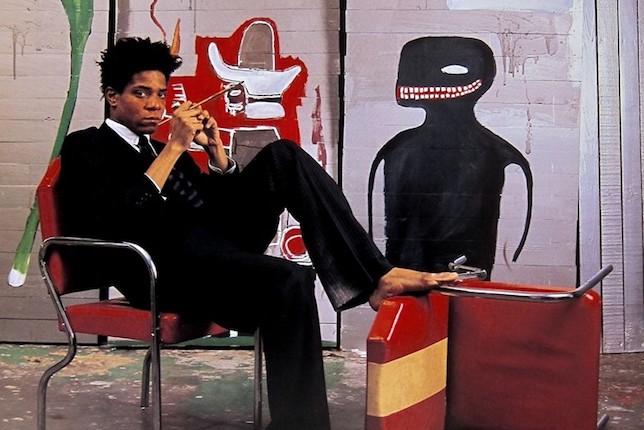
One of the major artists to know for Black History Month is Basquiat. He made it as a mixed-race artist in the 1980s, in a market that followed and perpetuated a pattern of categorically white elitism.
Mixing various media and symbols, he drew inspiration from everything: an anatomy book, the streets of New York, pop culture or boxing – all the while retaining a preoccupation with mortality and a desire to represent the black condition.
Tragically passing away from an overdose at the age of 27, Basquiat was an exceptional young artist who pushed the boundaries of the avant-garde. He experienced a meteoric rise to fame, and the value of his works have since seen an unprecedented growth: between 2000 and 2018, their worth increased by 1,000%.
OneEyedDiva
SF VIP
- Location
- New Jersey
I always thought my great grandfather resembled him.George Washington Carver was an agricultural scientist and inventor who developed hundreds of products using peanuts (though not peanut butter, as is often claimed), sweet potatoes and soybeans. Born into slavery a year before it was outlawed, Carver left home at a young age to pursue education and would eventually earn a master’s degree in agricultural science from Iowa State University. He would go on to teach and conduct research at Tuskegee University for decades, and soon after his death his childhood home would be named a national monument — the first of its kind to honor an African American.
photo taken c. 1910.
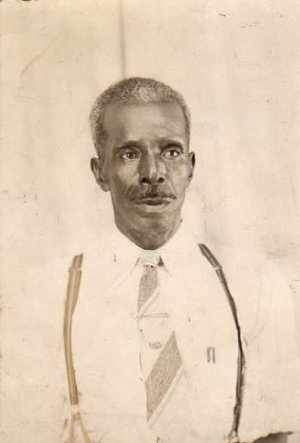
OneEyedDiva
SF VIP
- Location
- New Jersey
@Pecos @Pinky @dseag2 @SeaBreeze
I substituted what I copied and pasted from Wikipedia about the Harlem Hellfighters with the one I was originally trying to find which was posted on Bing yesterday. Thank you so much for your participation in that thread. Just an FYI in case you care to read the updated post. Scroll up a bit.
I substituted what I copied and pasted from Wikipedia about the Harlem Hellfighters with the one I was originally trying to find which was posted on Bing yesterday. Thank you so much for your participation in that thread. Just an FYI in case you care to read the updated post. Scroll up a bit.
Nathan
SF VIP
- Location
- High Desert- Calif.
SmoothSeas
Senior Member
SmoothSeas
Senior Member
Geezer Garage
Senior Member
- Location
- Steamboat Springs CO
In Honor of Black History month... I continue to treat all my fellow humans with love, empathy, and respect. Mike
SmoothSeas
Senior Member
In Honor of Black History month... I continue to treat all my fellow humans with love, empathy, and respect. Mike
as should we all...
JaniceM
Well-known Member
- Location
- still lost between two shores..
9 months earlier, 15-year-old Claudette Colvin did the same.…..February 4, 1913 ~
Remembering ROSA PARKS, today on her birthday ~
She took a stand by taking a seat.
https://www.bbc.com/news/stories-43171799
SmoothSeas
Senior Member
and yet another life story that deserves to be shared...
Biddy Bridget Mason (1815-1891)
She was born into slavery and "given" as a wedding gift to a Mormon couple in Mississippi named Robert and Rebecca Smith. In 1847 at age 32, Biddy Mason was forced to walk from Mississippi to Utah tending to the cattle behind her master’s 300-wagon caravan. She "walked" from Mississippi to Utah. That's 1, 618.9 miles!
After four years in Salt Lake City, Smith took the group to a new Mormon settlement in San Bernardino, California in search of gold. Biddy Mason soon discovered that the California State Constitution made slavery illegal, and that her master's had a plan to move them all to Texas to avoid freeing them.
With the help of some freed Blacks she had befriended, she and the other Slaves attempted to run away to Los Angeles, but they were intercepted by Smith and brought back. However, when he tried to leave the state with his family and Slaves, a local posse prevented them from leaving.
Biddy had Robert Smith brought into court on a writ of habeas corpus. She, her daughters, and the ten other Slaves were held in jail for their own safety to protect them from an angry and violent pro-slavery mob until the Judge heard the case and granted their freedom.
Now free, Mason and her three daughters moved to Los Angeles where they worked and saved enough money to buy a house at 331 Spring Street in downtown Los Angeles. Biddy was employed as a Nurse, Midwife, and Domestic Servant. She was one of the first Black women to own land in the city of Los Angeles.
She had the intelligence and boldness to use part of her land as a temporary resting place for horses and carriages, and people visiting town paid money in exchange for the space. That particular area was considered the first "parking lot" in Los Angeles.
Knowing what it meant to be oppressed and friendless, Biddy Mason immediately began a philanthropic career by opening her home to the poor, hungry, and homeless. Through hard work, saving, and investing carefully, she was able to purchase large amounts of real estate including a commercial building, which provided her with enough income to help build schools, hospitals, and churches.
Her financial fortunes continued to increase until she accumulated a fortune of almost $300,000. In today's money, that would be $6M. Her most noted accomplishment is the founding of the First AME Church in California. In her tireless work she was known for saying "If you hold your hand closed, nothing good can come in. The open hand gives in abundance; even as it receives."
Biddy Bridget Mason died on January 15, 1891 at the age of 76. On March 27, 1988, ninety one years after her death, a special occasion event was given in her honor by members of the church she helped founded. Mayor Tom Bradley was among the dignitaries in attendance.
Biddy Bridget Mason (1815-1891)
She was born into slavery and "given" as a wedding gift to a Mormon couple in Mississippi named Robert and Rebecca Smith. In 1847 at age 32, Biddy Mason was forced to walk from Mississippi to Utah tending to the cattle behind her master’s 300-wagon caravan. She "walked" from Mississippi to Utah. That's 1, 618.9 miles!
After four years in Salt Lake City, Smith took the group to a new Mormon settlement in San Bernardino, California in search of gold. Biddy Mason soon discovered that the California State Constitution made slavery illegal, and that her master's had a plan to move them all to Texas to avoid freeing them.
With the help of some freed Blacks she had befriended, she and the other Slaves attempted to run away to Los Angeles, but they were intercepted by Smith and brought back. However, when he tried to leave the state with his family and Slaves, a local posse prevented them from leaving.
Biddy had Robert Smith brought into court on a writ of habeas corpus. She, her daughters, and the ten other Slaves were held in jail for their own safety to protect them from an angry and violent pro-slavery mob until the Judge heard the case and granted their freedom.
Now free, Mason and her three daughters moved to Los Angeles where they worked and saved enough money to buy a house at 331 Spring Street in downtown Los Angeles. Biddy was employed as a Nurse, Midwife, and Domestic Servant. She was one of the first Black women to own land in the city of Los Angeles.
She had the intelligence and boldness to use part of her land as a temporary resting place for horses and carriages, and people visiting town paid money in exchange for the space. That particular area was considered the first "parking lot" in Los Angeles.
Knowing what it meant to be oppressed and friendless, Biddy Mason immediately began a philanthropic career by opening her home to the poor, hungry, and homeless. Through hard work, saving, and investing carefully, she was able to purchase large amounts of real estate including a commercial building, which provided her with enough income to help build schools, hospitals, and churches.
Her financial fortunes continued to increase until she accumulated a fortune of almost $300,000. In today's money, that would be $6M. Her most noted accomplishment is the founding of the First AME Church in California. In her tireless work she was known for saying "If you hold your hand closed, nothing good can come in. The open hand gives in abundance; even as it receives."
Biddy Bridget Mason died on January 15, 1891 at the age of 76. On March 27, 1988, ninety one years after her death, a special occasion event was given in her honor by members of the church she helped founded. Mayor Tom Bradley was among the dignitaries in attendance.


